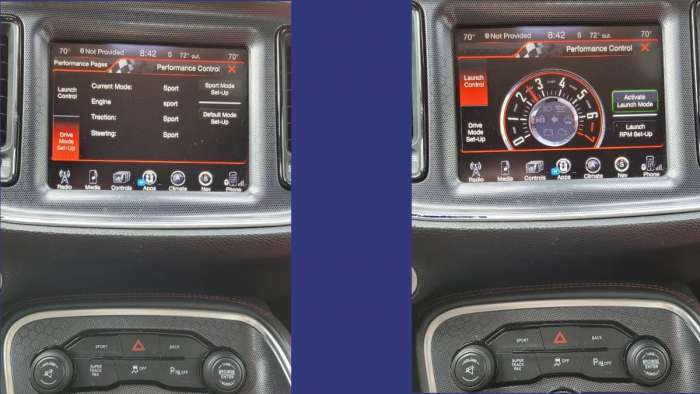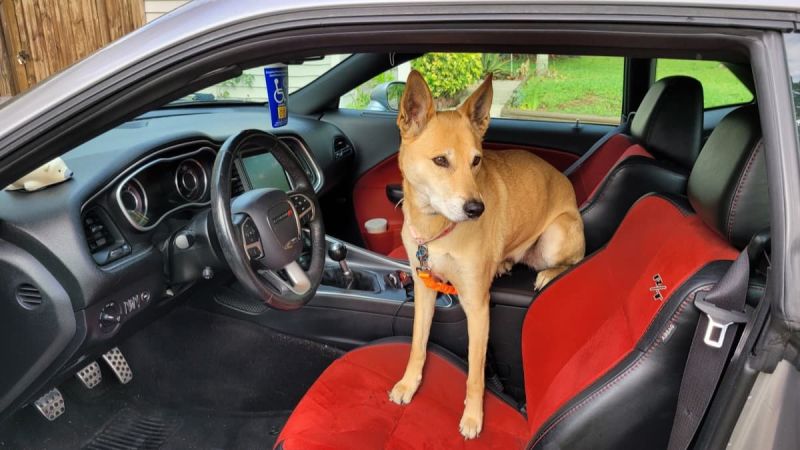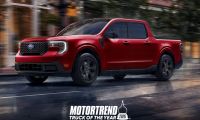As someone who was very seriously considering a 1969 Ford Mustang with the 302 cubic inch V8 and 4 speed manual, sitting in the 2016 Dodge Challenger’s Cockpit is more akin to a rocket ship or Jet-Aircraft than the analog instrument clusters of yore.

Gone are most of the needle-and-dial gauges from the dash, replaced instead with the Driver Information Display (DID), an intuitive interface that allows the driver to better understand the intricate goings on in their chariot.
The Dodge Challenger has a similar system to the Charger, and as such the software is pretty much the same between models, if you have the advanced performance package anyway.
To the right of the steering wheel is the Uconnect display, an infotainment system that quite puts the unit that had been in my newer (2019) Subaru Legacy to shame. It has a built-in navigation system, a somewhat utilitarian media system that works well with my Samsung Galaxy Note 20 5G, a climate control and seat control system, and most important for our purposes, the Performance Pages control system!

From the performance page, the driver is able to select the settings that fit their needs at the time, including a launch mode that allows the owner to select a specified RPM that the engine will try to hold for the launch. This launch mode, according to the owner’s guide, includes special traction control settings that seem like they increase the frequency at which the vehicle’s computer checks whether or not the wheel is spinning free. The guide itself is a little vague as to how the Launch mode manages its mechanical magic that allows for some scorching track performances (remember to never drive recklessly and that public roads are not for motorsport!).
Some users have had difficulty with launch mode- it’s important to have the brake fully depressed, the vehicle in gear, and to briskly and completely push the gas to the floor. If you’re driving a stick-shift, you’ll instead be more concerned with the clutch than the brake, but you’ll still have to quickly Floor it to get Launch mode to activate correctly. When it does, the results are spectacular and again, put a giant smile on my face every time.
Another thing that’s important to note here is that Launch mode effectively sets the RPM that your engine holds despite you flooring it, preventing you from over-revving when the clutch drops. For us Manual drivers, the factory sets the RPM at 3000, another thing to keep in mind when you’re setting your own Launch preferences. I saw one driver set his to 1500 rpm, but this didn't seem to work out well for him. It is worth noting that you are taking into account a lot of variables when setting your launch RPM, like tire and pavement temperature, tire compound (its stickiness), and ambient humidity.
I personally have laid out a 5.0 second 0-60 MPH dash. That is not super impressive; as the best drivers manage 4.8 second launches out of their stock 5.7 L beasts (some people don't keep their rides stock in the slightest), but it sure is a lot faster than what I’d been used to from my vehicles in the past, and it sure feels like a blast when the car is just barely holding onto the pavement, her rear tires spitting and starting their staccato squeal. I have my Launch control set to 2500 rpm because my tires are a little more worn than they should be for real motorsports play, and I haven’t yet had a chance to put new tires on my baby, but still wanted to see if I could have a little bit of fun out at the track.
Another feature of the Performance Pages system is the engine performance settings option that changes the throttle response and helps you get more direct control of how your ride is chugging down sweet petrol. This increased responsiveness helps to make my Billet Silver chariot explode into life and roar down the track at blistering, break-neck speeds. An important thing to note here, is that Dodge’s “Drive Mode Supplement,” a booklet that came with the owner’s manual and has a lot of useful information about the different settings in Performance Pages and DID, recommends against using launch mode in particularly slick conditions, like loose gravel, or wet pavement.
Compared to the rather simple dashboards and gauge clusters of yesteryear, electronic infotainment systems run the gamut from spartan and utilitarian to lavish and over-complex. Some modern manufacturers seem to miss the mark when it comes to design, but I’d like to say that in my opinion, Dodge’s DID and Uconnect display are top notch when it comes to giving the driver all the information they’ll need to properly use their vehicle for… therapeutic driving.
Frank DiMuccio has been interested in the automotive industry since his childhood. In high school, he spent his free-time rebuilding his car and earned a newfound enjoyment of the grease and sweat of working in the garage. He can be followed on Twitter at @Fdimuccio4 for daily automotive news.











